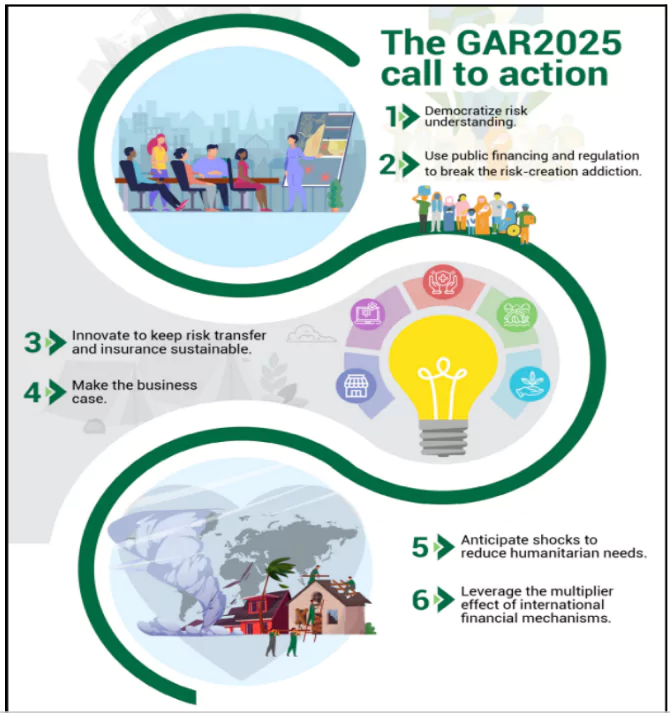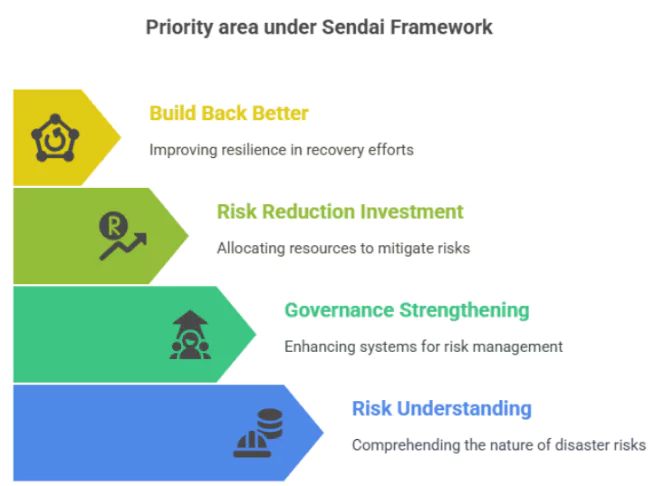Recently, the United Nations Office for Disaster Risk Reduction (UNDRR) released the Global Assessment Report on Disaster Risk Reduction (GAR) 2025, titled “Resilience Pays: Financing and Investing for our Future”.
Key Findings of GAR 2025
- Rising Economic Costs of Disasters: Disaster-related costs now exceed $2.3 trillion annually when cascading impacts and ecosystem damages are considered, highlighting an unsustainable economic trajectory.
 Between 1970–2000, disaster costs averaged $70–80 billion annually; this figure rose to $180–200 billion between 2001–2020, showing a consistent upward trend.
Between 1970–2000, disaster costs averaged $70–80 billion annually; this figure rose to $180–200 billion between 2001–2020, showing a consistent upward trend.
- Low Insurance Coverage Globally: Most disaster impacts remain uninsured, even in developed nations, making recovery more difficult and increasing long-term financial vulnerability.
- High Vulnerability of Developing Nations: As of 2023, only 49% of Least Developed Countries (LDCs) had access to multi-hazard early warning systems, leaving many exposed to avoidable risks.
- Insufficient Investment in Risk Prevention: Only 2% of development aid is directed toward Disaster Risk Reduction (DRR), despite evidence that $1 invested in DRR saves $15 in recovery costs.
Impact of Disaster in India
- Infrastructure Losses : In 2019, Cyclone Fani caused $1.2 billion in damages to Odisha’s power infrastructure, showing the vulnerability of critical sectors to extreme weather.
- Displacement: India witnessed 10 to 30 million internal displacements due to climate-related disasters, demonstrating the country’s exposure to climate-induced migration and instability.
- Impact on Living Standards: Changing weather patterns and their effect on agriculture and livelihoods could reduce living standards by 9% by 2050, particularly in rural and vulnerable communities.
- Low Insurance Penetration: India’s insurance coverage remains below 1%, severely limiting the country’s ability to share or transfer disaster-related risks.
About the United Nations Office for Disaster Risk Reduction (UNDRR)

- The UNDRR is the UN’s lead agency for disaster risk reduction, responsible for supporting global efforts to build resilient societies and reduce disaster impacts.
- Establishment: UNDRR was established in 1999 and functions under the United Nations Secretariat, with a mandate to implement the global framework for disaster risk reduction.
- Flagship Reports: The Global Assessment Report (GAR) is UNDRR’s biennial flagship publication that evaluates global progress, risks, and financial dimensions of disaster resilience.
Key Initiatives under UNDRR
- UNDRR supports the Sendai Framework for Disaster Risk Reduction (2015–2030), which guides international efforts to reduce disaster risks.
- The Sendai Framework for Disaster Risk Reduction is the successor to the Hyogo Framework for Action (2005–2015), building on past lessons to create a more robust disaster risk reduction strategy.
- The framework outlines seven global targets, including reducing disaster mortality, economic loss, and infrastructure damage, while improving early warning systems and risk understanding.
- National Commitment: The framework emphasizes a shared responsibility among governments, communities, and businesses, calling for risk-informed investment and systemic planning at all levels.
Conclusion
The GAR 2025 reinforces the urgent need for a paradigm shift towards risk-informed development. For countries like India, aligning infrastructure, finance, and climate policies with disaster resilience is essential to safeguard lives, economies, and ecosystems in a climate-changed world.
![]() 30 May 2025
30 May 2025

 Between 1970–2000, disaster costs averaged $70–80 billion annually; this figure rose to $180–200 billion between 2001–2020, showing a consistent upward trend.
Between 1970–2000, disaster costs averaged $70–80 billion annually; this figure rose to $180–200 billion between 2001–2020, showing a consistent upward trend.
